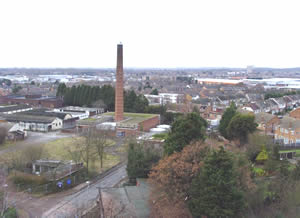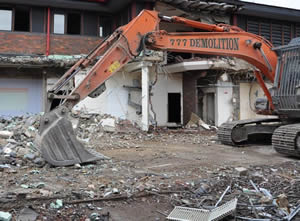Harold Wood Hospital, Barking



Project Summary
| Client: | Countryside Poroerties |
| Sector: | Healthcare |
| Location: | Barking, London |
| QS: | Countryside Poroerties |
| Contract Value: | £1.3m |
| No. of Units: | N/A |
| No. of Floors: | 6 |
| Demo Period: | 36 Weeks |
| Completion Date: | August 2012 |
In December 2006 the hospital was closed by Barking, Havering and Redbridge Hospitals Trust and the site earmarked for regeneration with a plan for 780 houses drawn up.
777Demolition and Haulage Ltd won a competitive tender issued by the Countryside Properties who where developing the former hospital site. With 777 acting as Principal Contractor under the CDM regulations work on the project began in December 2011. The works consisted of the demolition of 73 buildings and remediate the land they stood on.
Before the demolition phase of the works could begin, there was a need to identify and remove all residual asbestos from the condemned buildings. The quantity of ACM’s to be handled and eventually removed was measured at 315 tonnes. With the asbestos removed and clearance certificates obtained, the buildings were stripped of their interior fixtures and fittings. The site housed a 2km long, three metre deep utility tunnel as well as numerous unmarked water pits. All these factors were taken into account after an in-depth demolition survey production of the demolition plan and numerous method statements and associated risk assessments followed by planned sequencing and monitoring of the site activities.
Challenges
Due to the ‘hap-hazard’ nature of the hospital’s growth over the last century, the demolition phase of the project presented a number of challenges. The hospital was a sprawl of randomly placed structures from different eras that took different forms. This was mainly due to the service it provided during the second world war.
The hospital’s grounds were x-rayed to identify areas where ammunition and other ordinance may have been buried. This precaution was due to certain parts of the hospital’s grounds having been used as a temporary marshalling yard for the adjacent railway. During the war it was reported that munitions were taken from trains and stockpiled on the site. Analysing the ground generated several areas deemed likely to house munitions and these were isolated during the demolition phase.
A 25m-high chimney stood amongst five-storey office buildings from the 1960s, post-war accommodation blocks and older, antiquated buildings housing the hospital’s utilities such as boilers and generators. Most of the buildings contained Asbestos and all had suffered damage due to vandals and thieves.
How we made a difference
777 deployed over 18 pieces of demolition machinery en-mass to clear the site of its antiquated structures. The largest machines dispatched were two of the company’s giant Hitachi EX1200 super high reach demolition rigs. The Hitachi’s were able to bring down the site’s chimney and 1960s office block. The task of clearing the remaining buildings fell to 12 smaller excavators consisting of Volvo EC360s, Komatsu PC210s and PC450s as well as Hitachi Zaxis 210s and 350s. The excavators utilised a wide variety of attachments including grapples, pulverisers and hammers on the dilapidated buildings and subsequent arisings.
Due to the number of machines at work, the company established its own plant / vehicle maintenance facility on site, allowing equipment to be serviced or repaired in-situ rather than being transported back to 777 Group’s depot in Croydon.


